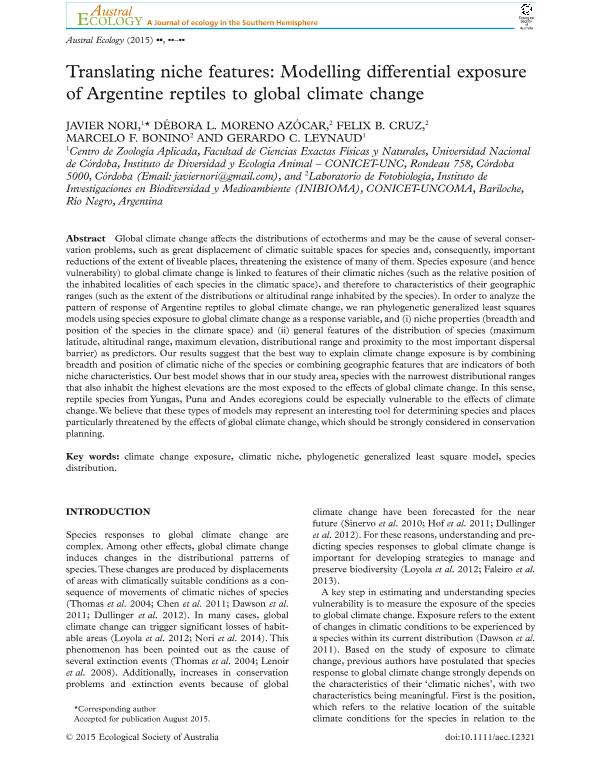Artículo
Translating Niche Features: Modeling Differential Exposure of Argentine Reptiles to Global Climate Change
Nori, Javier; Moreno Azócar, Débora Lina ; Cruz, Felix Benjamin
; Cruz, Felix Benjamin ; Bonino, Marcelo Fabián
; Bonino, Marcelo Fabián ; Leynaud, Gerardo Cristhian
; Leynaud, Gerardo Cristhian
 ; Cruz, Felix Benjamin
; Cruz, Felix Benjamin ; Bonino, Marcelo Fabián
; Bonino, Marcelo Fabián ; Leynaud, Gerardo Cristhian
; Leynaud, Gerardo Cristhian
Fecha de publicación:
08/2015
Editorial:
Wiley
Revista:
Austral Ecology
ISSN:
1442-9985
Idioma:
Inglés
Tipo de recurso:
Artículo publicado
Clasificación temática:
Resumen
Global climate change affects the distributions of ectotherms and may be the cause of several conservation problems, such as great displacement of climatic suitable spaces for species and, consequently, important reductions of the Extent of liveable places, threatening the existence of many of them. Species exposure (and hence vulnerability) to global climate change is linked to features of their climatic niches (such as the relative position of the inhabited localities of each species in the climatic space), and therefore to characteristics of their geographic ranges (such as the extent of the distributions or altitudinal range inhabited by the species). In order to analyze the pattern of response of Argentine reptiles to global climate change, we ran phylogenetic generalized least squares models using species exposure to global climate change as a response variable, and (i) niche properties (breadth and position of the species in the climate space) and (ii) general features of the distribution of species (maximum latitude, altitudinal range, maximum elevation, distributional range and proximity to the most important dispersalbarrier) as predictors. Our results suggest that the best way to explain climate change exposure is by combining breadth and position of climatic niche of the species or combining geographic features that are indicators of both niche characteristics. Our best model shows that in our study area, species with the narrowest distributional ranges that also inhabit the highest elevations are the most exposed to the effects of global climate change. In this sense, reptile species from Yungas, Puna and Andes ecoregions could be especially vulnerable to the effects of climate change.We believe that these types of models may epresent an interesting tool for determining species and places particularly threatened by the effects of global climate change, which should be strongly considered in conservation planning.
Palabras clave:
Climate Change
,
Climatic Niche
,
Phylogenetic Model
,
Distribution
Archivos asociados
Licencia
Identificadores
Colecciones
Articulos(IDEA)
Articulos de INSTITUTO DE DIVERSIDAD Y ECOLOGIA ANIMAL
Articulos de INSTITUTO DE DIVERSIDAD Y ECOLOGIA ANIMAL
Citación
Nori, Javier; Moreno Azócar, Débora Lina; Cruz, Felix Benjamin; Bonino, Marcelo Fabián; Leynaud, Gerardo Cristhian; Translating Niche Features: Modeling Differential Exposure of Argentine Reptiles to Global Climate Change; Wiley; Austral Ecology; 41; 4; 8-2015; 367-375
Compartir
Altmétricas



